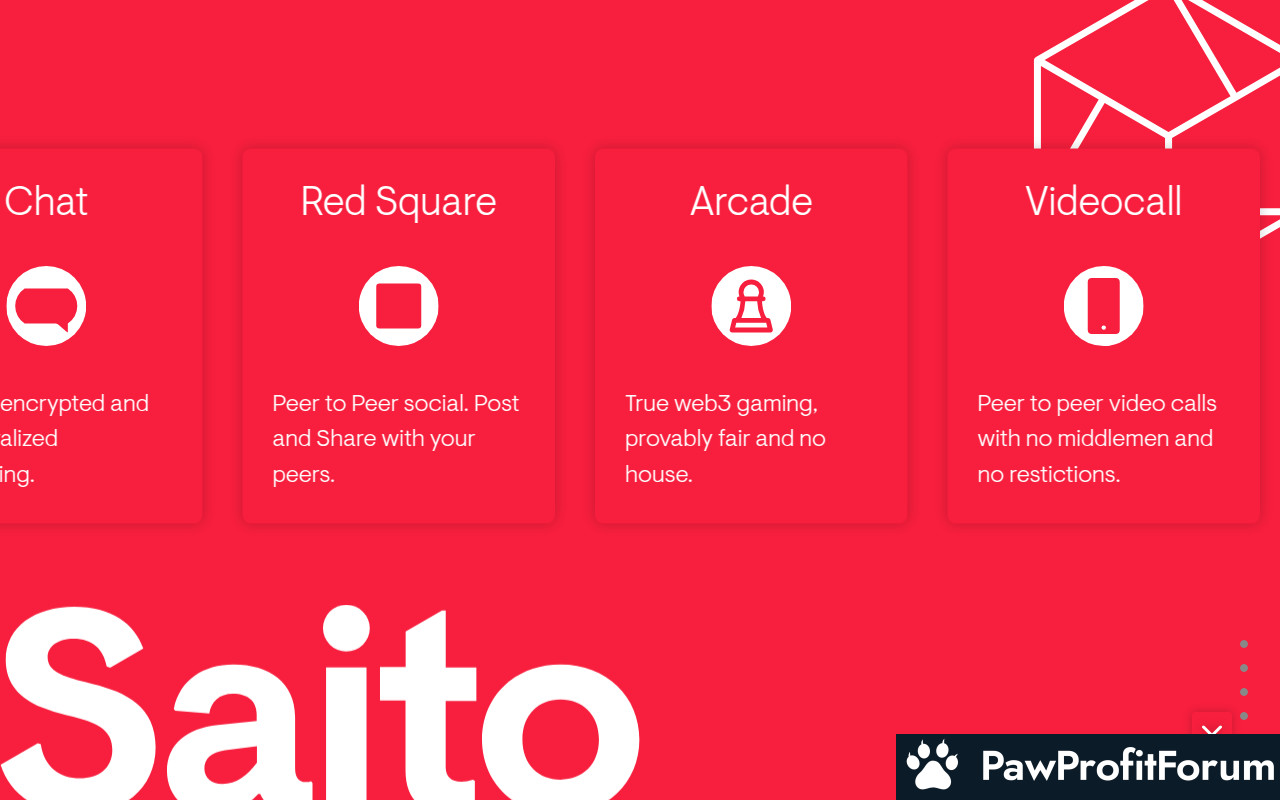Saito is a Layer 1 blockchain with novel mechanisms designed to solve difficult economic problems that all blockchains suffer from.
Routing Work rewards network service providers over miners and stakers, enabling accountability and funding for infrastructure which provides the best access into the network.
Automatic Transaction Rebroadcasting (ATR) is an innovative 'rent' system which leverages dynamic market pricing rather than predetermined rates, protecting the system from ever-increasing data bloat and poor pricing.
Saito applications utilize the blockchain as a PKI in the browser, bootstrapping fully secure P2P connections rather than relying on central, trusted servers.
A distinctive feature of Saito is its ability to run blockchain applications directly in your browser, a capability supported by its status as a Web3 Foundation grant recipient. This browser-based functionality facilitates seamless interaction with decentralized applications (dApps) without the need for intermediaries. By paying ISPs instead of miners or stakers, Saito enables Web3 projects to self-fund their infrastructure, effectively bypassing the need for centralized services like Infura.
Saito's open network architecture ensures automatic and unforgeable compensation for network nodes, fostering a more decentralized and resilient ecosystem. This innovative model not only democratizes access to blockchain technology but also mitigates the risk of centralization, which is a common concern in many existing blockchain networks.
One of the standout features of Saito is its ability to run blockchain applications directly in your browser. This is a significant leap forward in terms of accessibility and ease of use. By enabling applications to run in a browser, Saito eliminates the need for users to download specialized software or rely on centralized services. This browser-based functionality is part of Saito's broader mission to support Web3 projects, which aim to create a more decentralized and user-centric internet.
The technology behind Saito also includes a distributed, global Public Key Infrastructure (PKI) layer. PKI is essential for securing communications and transactions on the internet. By distributing this layer globally, Saito enhances the security and reliability of its network, making it more resilient to attacks from bad actors. This distributed PKI layer is a critical component in ensuring that the network remains secure and trustworthy.
Another intriguing aspect of Saito is its focus on decentralization and scalability. Traditional blockchains often face challenges related to scalability, as increasing the number of transactions can lead to slower processing times and higher fees. Saito addresses these issues by providing a scalable foundation that can support a wide range of decentralized applications. This scalability is crucial for the long-term success and adoption of blockchain technology.
Saito's approach to preventing attacks from bad actors is also noteworthy. By paying ISPs instead of miners or stakers, Saito reduces the risk of centralization and the associated vulnerabilities. This payment model incentivizes ISPs to maintain the network's integrity, as their compensation is directly tied to the network's performance and security. This innovative approach helps to create a more robust and secure blockchain ecosystem.
Moreover, Saito is a recipient of a Web3 Foundation grant, which underscores its commitment to advancing the development of decentralized web technologies. The support from the Web3 Foundation highlights the potential of Saito to contribute significantly to the evolution of the internet, making it more open, secure, and user-friendly.
In terms of technical implementation, Saito's consensus mechanism is designed to be both efficient and secure. By leveraging a combination of cryptographic techniques and economic incentives, Saito ensures that transactions are processed quickly and accurately. This consensus mechanism is a key factor in the network's ability to scale and support a diverse range of applications.
The Saito Whitepaper provides a detailed overview of the technical aspects of the protocol, including its consensus mechanism, PKI layer, and approach to decentralization. For those interested in a deeper dive into the technology, the whitepaper is an invaluable resource that offers comprehensive insights into how Saito operates and the principles that guide its development.
In essence, Saito represents a significant advancement in blockchain technology, offering a unique combination of decentralization, scalability, and user-centric design. By focusing on paying ISPs and running applications directly in the browser, Saito addresses some of the most pressing challenges facing the blockchain industry today. This innovative approach positions Saito as a key player in the ongoing evolution of decentralized technologies.
A key real-world application of Saito is in building decentralized applications (DAPPs). Unlike traditional blockchain networks that rely on miners or stakers, Saito uses a unique consensus mechanism that pays Internet Service Providers (ISPs) for maintaining the network. This approach not only decentralizes the network but also reduces the reliance on centralized entities, making it more resilient and cost-effective.
Saito also provides a distributed, global Public Key Infrastructure (PKI) layer. This is crucial for automating key exchanges and securing communications over the internet. By offering a decentralized PKI, Saito enhances security and trust in digital interactions, which is particularly beneficial for applications requiring robust security measures.
Another significant application of Saito is in powering peer-to-peer applications. These applications can range from simple messaging services to complex data-sharing platforms. By leveraging Saito's high throughput and efficient consensus mechanism, developers can create scalable and efficient peer-to-peer networks without the bottlenecks commonly associated with traditional blockchain systems.
Additionally, Saito offers a data network for decentralized applications. This network can be used to store and manage data in a decentralized manner, ensuring that no single entity has control over the data. This is particularly useful for applications that require high levels of data integrity and security, such as financial services, healthcare, and supply chain management.
Saito's innovative approach to funding infrastructure costs also allows Web3 projects to self-fund. Instead of relying on external funding or passing costs onto users, projects built on Saito can sustain themselves by paying ISPs directly. This model promotes a more sustainable and equitable ecosystem for decentralized applications.
One of the pivotal moments for Saito was the release of their Tier 1 Blockchain Protocol. This protocol is designed to enhance the scalability and efficiency of blockchain applications, making it a significant milestone in the network's development. By focusing on a consensus mechanism that compensates ISPs, Saito aims to eliminate the reliance on centralized entities like Infura, which often dominate the infrastructure landscape.
Another noteworthy development was the implementation of a distributed, global Public Key Infrastructure (PKI) layer. This addition is crucial for enhancing the security and trustworthiness of the network, providing a robust framework for identity verification and secure communications within the blockchain ecosystem.
Saito has also been proactive in releasing comprehensive documentation and a detailed roadmap for future developments. These resources offer insights into the network's long-term vision and strategic goals, providing the community and potential partners with a clear understanding of what to expect in the coming years.
Partnerships have played a significant role in Saito's journey. The network has formed alliances with various companies and platforms, which has been instrumental in gaining traction and increasing adoption. These collaborations not only validate Saito's technology but also expand its reach and application across different sectors.
In terms of recognition, Saito is a Web3 Foundation grant recipient. This accolade underscores the network's potential and the innovative nature of its approach to blockchain technology. The grant has likely provided additional resources and support, further accelerating Saito's development and implementation of new features.
The future plans for Saito suggest a trajectory of continued growth and development. The network's unique approach to compensating ISPs and its focus on decentralizing infrastructure costs position it well for broader adoption and integration into various Web3 projects.
David Lancashire and Richard Parris are the founders of Saito. Lancashire has a background in technology and blockchain, contributing significantly to the conceptual framework of Saito. Parris, with his extensive experience in software development, has played a crucial role in the technical implementation and development of the network. Both founders are recognized for their innovative approach to decentralizing web infrastructure.
Routing Work rewards network service providers over miners and stakers, enabling accountability and funding for infrastructure which provides the best access into the network.
Automatic Transaction Rebroadcasting (ATR) is an innovative 'rent' system which leverages dynamic market pricing rather than predetermined rates, protecting the system from ever-increasing data bloat and poor pricing.
Saito applications utilize the blockchain as a PKI in the browser, bootstrapping fully secure P2P connections rather than relying on central, trusted servers.
What is Saito?
Saito (SAITO) stands out in the blockchain landscape as a Tier 1 Blockchain Protocol designed to deliver high throughput. Unlike traditional blockchain networks that rely on miners or stakers, Saito employs a unique consensus mechanism that compensates Internet Service Providers (ISPs) within the network. This approach not only enhances scalability but also introduces a distributed, global Public Key Infrastructure (PKI) layer.A distinctive feature of Saito is its ability to run blockchain applications directly in your browser, a capability supported by its status as a Web3 Foundation grant recipient. This browser-based functionality facilitates seamless interaction with decentralized applications (dApps) without the need for intermediaries. By paying ISPs instead of miners or stakers, Saito enables Web3 projects to self-fund their infrastructure, effectively bypassing the need for centralized services like Infura.
Saito's open network architecture ensures automatic and unforgeable compensation for network nodes, fostering a more decentralized and resilient ecosystem. This innovative model not only democratizes access to blockchain technology but also mitigates the risk of centralization, which is a common concern in many existing blockchain networks.
What is the technology behind Saito?
Saito (SAITO) is a fascinating blockchain technology that stands out in the crowded world of cryptocurrencies. At its core, Saito is a Tier 1 Blockchain Protocol, which means it serves as the foundational layer for building decentralized applications. Unlike many other blockchains that rely on miners or stakers to validate transactions, Saito employs a unique consensus mechanism that compensates Internet Service Providers (ISPs) within the network. This approach not only decentralizes the network but also ensures that the infrastructure costs are not passed on to monopolistic entities.One of the standout features of Saito is its ability to run blockchain applications directly in your browser. This is a significant leap forward in terms of accessibility and ease of use. By enabling applications to run in a browser, Saito eliminates the need for users to download specialized software or rely on centralized services. This browser-based functionality is part of Saito's broader mission to support Web3 projects, which aim to create a more decentralized and user-centric internet.
The technology behind Saito also includes a distributed, global Public Key Infrastructure (PKI) layer. PKI is essential for securing communications and transactions on the internet. By distributing this layer globally, Saito enhances the security and reliability of its network, making it more resilient to attacks from bad actors. This distributed PKI layer is a critical component in ensuring that the network remains secure and trustworthy.
Another intriguing aspect of Saito is its focus on decentralization and scalability. Traditional blockchains often face challenges related to scalability, as increasing the number of transactions can lead to slower processing times and higher fees. Saito addresses these issues by providing a scalable foundation that can support a wide range of decentralized applications. This scalability is crucial for the long-term success and adoption of blockchain technology.
Saito's approach to preventing attacks from bad actors is also noteworthy. By paying ISPs instead of miners or stakers, Saito reduces the risk of centralization and the associated vulnerabilities. This payment model incentivizes ISPs to maintain the network's integrity, as their compensation is directly tied to the network's performance and security. This innovative approach helps to create a more robust and secure blockchain ecosystem.
Moreover, Saito is a recipient of a Web3 Foundation grant, which underscores its commitment to advancing the development of decentralized web technologies. The support from the Web3 Foundation highlights the potential of Saito to contribute significantly to the evolution of the internet, making it more open, secure, and user-friendly.
In terms of technical implementation, Saito's consensus mechanism is designed to be both efficient and secure. By leveraging a combination of cryptographic techniques and economic incentives, Saito ensures that transactions are processed quickly and accurately. This consensus mechanism is a key factor in the network's ability to scale and support a diverse range of applications.
The Saito Whitepaper provides a detailed overview of the technical aspects of the protocol, including its consensus mechanism, PKI layer, and approach to decentralization. For those interested in a deeper dive into the technology, the whitepaper is an invaluable resource that offers comprehensive insights into how Saito operates and the principles that guide its development.
In essence, Saito represents a significant advancement in blockchain technology, offering a unique combination of decentralization, scalability, and user-centric design. By focusing on paying ISPs and running applications directly in the browser, Saito addresses some of the most pressing challenges facing the blockchain industry today. This innovative approach positions Saito as a key player in the ongoing evolution of decentralized technologies.
What are the real-world applications of Saito?
Saito (SAITO) is a blockchain platform designed to address some of the fundamental issues in the current cryptocurrency landscape. One of its standout features is its ability to run blockchain applications directly in a web browser, which simplifies access and usability for a wide range of users.A key real-world application of Saito is in building decentralized applications (DAPPs). Unlike traditional blockchain networks that rely on miners or stakers, Saito uses a unique consensus mechanism that pays Internet Service Providers (ISPs) for maintaining the network. This approach not only decentralizes the network but also reduces the reliance on centralized entities, making it more resilient and cost-effective.
Saito also provides a distributed, global Public Key Infrastructure (PKI) layer. This is crucial for automating key exchanges and securing communications over the internet. By offering a decentralized PKI, Saito enhances security and trust in digital interactions, which is particularly beneficial for applications requiring robust security measures.
Another significant application of Saito is in powering peer-to-peer applications. These applications can range from simple messaging services to complex data-sharing platforms. By leveraging Saito's high throughput and efficient consensus mechanism, developers can create scalable and efficient peer-to-peer networks without the bottlenecks commonly associated with traditional blockchain systems.
Additionally, Saito offers a data network for decentralized applications. This network can be used to store and manage data in a decentralized manner, ensuring that no single entity has control over the data. This is particularly useful for applications that require high levels of data integrity and security, such as financial services, healthcare, and supply chain management.
Saito's innovative approach to funding infrastructure costs also allows Web3 projects to self-fund. Instead of relying on external funding or passing costs onto users, projects built on Saito can sustain themselves by paying ISPs directly. This model promotes a more sustainable and equitable ecosystem for decentralized applications.
What key events have there been for Saito?
Saito (SAITO) is a blockchain network that stands out by running blockchain applications directly in users' browsers. This innovative approach allows the network to pay Internet Service Providers (ISPs) instead of traditional miners or stakers, addressing the issue of infrastructure costs in Web3 projects.One of the pivotal moments for Saito was the release of their Tier 1 Blockchain Protocol. This protocol is designed to enhance the scalability and efficiency of blockchain applications, making it a significant milestone in the network's development. By focusing on a consensus mechanism that compensates ISPs, Saito aims to eliminate the reliance on centralized entities like Infura, which often dominate the infrastructure landscape.
Another noteworthy development was the implementation of a distributed, global Public Key Infrastructure (PKI) layer. This addition is crucial for enhancing the security and trustworthiness of the network, providing a robust framework for identity verification and secure communications within the blockchain ecosystem.
Saito has also been proactive in releasing comprehensive documentation and a detailed roadmap for future developments. These resources offer insights into the network's long-term vision and strategic goals, providing the community and potential partners with a clear understanding of what to expect in the coming years.
Partnerships have played a significant role in Saito's journey. The network has formed alliances with various companies and platforms, which has been instrumental in gaining traction and increasing adoption. These collaborations not only validate Saito's technology but also expand its reach and application across different sectors.
In terms of recognition, Saito is a Web3 Foundation grant recipient. This accolade underscores the network's potential and the innovative nature of its approach to blockchain technology. The grant has likely provided additional resources and support, further accelerating Saito's development and implementation of new features.
The future plans for Saito suggest a trajectory of continued growth and development. The network's unique approach to compensating ISPs and its focus on decentralizing infrastructure costs position it well for broader adoption and integration into various Web3 projects.
Who are the founders of Saito?
Saito (SAITO) is a Web3 Foundation grant recipient that enables blockchain applications to run directly in your browser. The network compensates ISPs instead of miners or stakers, allowing Web3 projects to self-fund infrastructure and avoid passing costs to monopolistic entities.David Lancashire and Richard Parris are the founders of Saito. Lancashire has a background in technology and blockchain, contributing significantly to the conceptual framework of Saito. Parris, with his extensive experience in software development, has played a crucial role in the technical implementation and development of the network. Both founders are recognized for their innovative approach to decentralizing web infrastructure.
| Website | saito.io/ |
| Website | saito.io/saito-whitepaper.pdf |
| Socials | twitter.com/SaitoOfficial |
| Socials | reddit.com/r/saito |
| Socials | github.com/SaitoTech/saito-lite-rust |
| Socials | saito.io/chat/ |
| Contracts | 0xFa14...74B57B |
| Explorers | saito.io/explorer/ |
| Wallets | metamask.io/ |



